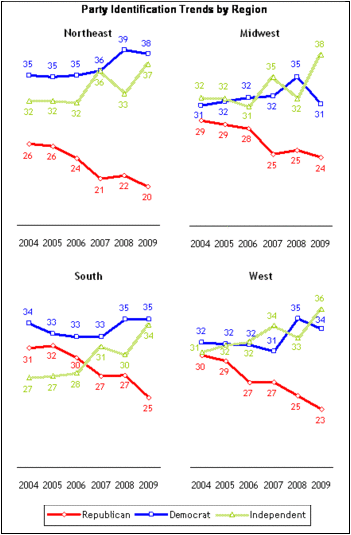KROMM REPORT: How is the "regional party of the South" doing in the South?
Especially since the 2008 elections, it's become a staple of political conventional wisdom to say the Republicans are "a regional party based in the South." The region is an especially favorite target for national pundits, who leap at the chance to find evidence (convincing or not) that the South is a uniquely Republican-dominated region out of step with national trends.
But how does one judge the strength or weakness of a political party in a given region? By presidential votes? But President Obama won a third of the South's Electoral College vote -- and the three states where Obama did the worst weren't in the South; they were Idaho, Utah and Wyoming.
Is it measured by who gets elected to Congress? True, 44% of the Republican House delegation is from Southern states -- but that means 56% come from somewhere else. And as a state like Florida shows -- where only 10 of the blue-trending state's 25 Representatives are Democrats -- that often has more to do with who drew the districts than the will of the voters.
Another measure that's received a lot of attention recently is party identification. Recent polls by the Pew Center and Gallup have both pointed to a broad national trend that shows the number of people who identify as Independents on the rise, Republicans in decline and Democrats roughly holding steady. As the always-helpful Nate Silver points out, these are in line with other recent polls.
So how does the South stack up to other regions in these surveys? According to Pew -- the one with the most detailed regional breakdown -- the South isn't much different than the rest of the country when it comes to the political affiliation residents claim.
In fact, in Pew's survey, only the Northeast had a profile of voters that was much different than the rest of the country -- and in many cases, the differences between regions were within the poll's margin of error. Here's a chart:

But how does one judge the strength or weakness of a political party in a given region? By presidential votes? But President Obama won a third of the South's Electoral College vote -- and the three states where Obama did the worst weren't in the South; they were Idaho, Utah and Wyoming.
Is it measured by who gets elected to Congress? True, 44% of the Republican House delegation is from Southern states -- but that means 56% come from somewhere else. And as a state like Florida shows -- where only 10 of the blue-trending state's 25 Representatives are Democrats -- that often has more to do with who drew the districts than the will of the voters.
Another measure that's received a lot of attention recently is party identification. Recent polls by the Pew Center and Gallup have both pointed to a broad national trend that shows the number of people who identify as Independents on the rise, Republicans in decline and Democrats roughly holding steady. As the always-helpful Nate Silver points out, these are in line with other recent polls.
So how does the South stack up to other regions in these surveys? According to Pew -- the one with the most detailed regional breakdown -- the South isn't much different than the rest of the country when it comes to the political affiliation residents claim.
In fact, in Pew's survey, only the Northeast had a profile of voters that was much different than the rest of the country -- and in many cases, the differences between regions were within the poll's margin of error. Here's a chart:

Tags
Chris Kromm
Chris Kromm is executive director of the Institute for Southern Studies and publisher of the Institute's online magazine, Facing South.
